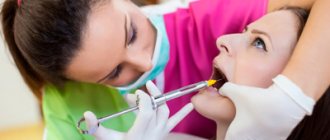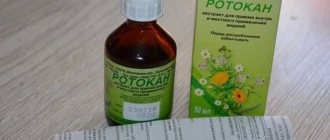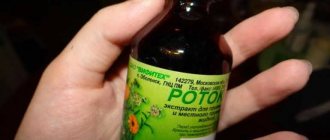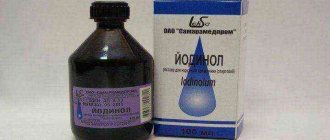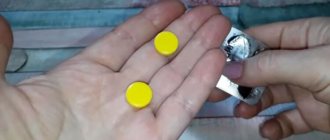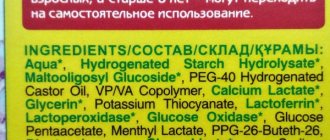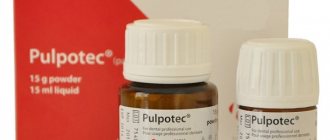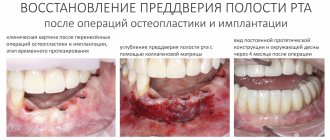Release forms and composition of the drug
The product is available in the form of an aqueous-alcoholic extract. It is a liquid with a pronounced herbal aroma, packaged in 50 ml dark glass bottles. Each bottle is placed in an individual cardboard box, where you can also find detailed instructions for proper use.
The product has a therapeutic effect due to the presence of several active components of plant origin:
- Calendula. The ingredient is present in the form of flowers.
- Chamomile in the form of flowers.
- herb .
As an auxiliary ingredient, the composition contains purified water and alcohol in small quantities. The last ingredient is considered the basis of the extract.
Composition of the drug, release form
Several varieties of medicinal plants are used in the production of the drug. Externally, the pharmaceutical product is a dark brown liquid and has a specific aroma. Plant extracts are obtained using a solution of alcohol in water.
Plant extracts included in Rotokan:
- 1 part common yarrow
- 2 parts chamomile
- 1 part medicinal calendula
The pharmaceutical product contains:
- tannins
- B vitamins
- quercetin
- chamazulene
Ethyl alcohol contained in the medicinal solution enhances the following effects of herbs:
- anti-inflammatory
- painkiller
- antiseptic
The medicine is marketed in the form of a liquid extract, which can be used orally or topically. The medicine is packaged in glass bottles that are equipped with droppers. For inpatient departments, the solution is released in brown jars of various capacities.
Pharmacological properties
Rotokan for rinsing gums during inflammation is effective due to the presence of herbal ingredients in the composition. The solution has antiseptic and anti-inflammatory properties, which makes it possible to use it for various pathologies of the mucous membranes of the oral cavity.
The medicine also has hemostatic properties. This is considered its advantage over other drugs from this pharmacological group. The drug helps not only to destroy microorganisms on the mucous membranes, but also prevents their re-production and spread to healthy tissues.
The hemostatic properties of the drug help prevent bleeding as a result of minor damage to the mucous membranes when brushing teeth and eating solid foods.
Pharmacodynamics and pharmacokinetics
When the solution is used externally, the therapeutic effect develops over several days after the start of the course. The active components of the product create a kind of protective film on the surface of the mucous membranes of the oral cavity, which not only destroys bacteria, but also prevents their re-spread and reproduction.
Calendula in the medicine helps speed up the process of tissue repair, improves local blood circulation and cell nutrition. Chamomile is considered a powerful natural antiseptic. When using the solution, local defenses increase, pain and swelling are eliminated. These symptoms of inflammation appear quite often.
The drug also has other properties:
- Yarrow herb has a stimulating effect. Has a positive effect on the condition of the mucous membranes.
- The drug prevents the spread of inflammation to healthy tissues and stops the progression of the disease.
- The solution has a mild effect, does not aggravate the course of the pathology and can be used in combination with other medications against oral diseases.
- Stops bleeding, even when it does not occur as a result of brushing your teeth.
- Stimulates cell renewal, prevents damage by pathogenic bacteria.
As a result of the complex effect on tissue, the recovery period is shortened and the development of complications is prevented. When taken orally, the active components are quickly distributed throughout the systemic bloodstream and have a therapeutic effect. They are well absorbed in the body, processed in the liver, and then excreted through the kidneys.
Metabolites of substances do not have a therapeutic effect. When applied topically, the drug is almost not absorbed into the blood, which is considered an advantage, since the risk of overdose is significantly reduced.
In patients with kidney pathologies, the period of cleansing the body from breakdown products of active components slows down somewhat, which can provoke a slight accumulation of substances in the blood. In severe cases of such pathologies, the drug is used in small doses, which greatly facilitates processing and elimination.
In each case, pharmacokinetic features may differ depending on the characteristics of the patient's body.
Treatment methods in gynecology
Rotocan in gynecology, douching, is the topic of our article today. As everyone knows, gynecology is the field of medicine that deals with the study of various female diseases.
What is douching in gynecology? This is a method of washing the vagina using various medicines or herbs. This procedure cannot be carried out without consulting a doctor, since unknowingly you can disrupt the delicate microflora of the vagina and cause undesirable consequences instead of the desired result. If you do the procedure thoughtlessly, it can cause disturbances in the vaginal environment and such an unpleasant disease as vaginosis.
Also, frequent use of this procedure can cause the development of thrush. This is far from a typical procedure for medical practice, and it has its pros and cons. Since it washes out the necessary bacteria and disrupts the microflora, not many specialists are ready to prescribe it. If your gynecologist prescribed this procedure for you, then you should strictly adhere to his recommendations, this is in order to preserve your health. Nowadays, this procedure is increasingly receding into the background, and gynecologists are trying to replace it with methods that are more gentle on the body.
Some doctors are inclined to believe that douching during erosion can damage the epithelium of the cervix, and therefore do not use it.
Indications for use
Rotokan is used for different patients, not only for rinsing when gum inflammation occurs.
There are other indications for use:
- Stomatitis of acute and chronic forms. In this case, the drug can be used for aphthous or ulcerative forms of the disease with severe symptoms. The condition is characterized by damage to the mucous membranes of the oral cavity, which leads to discomfort when eating food, liquids and other disorders.
- Inflammation of the gums after implantation.
- Gingivitis as a result of tooth extraction or a filling procedure. The product helps shorten the recovery period. After tooth extraction, complications in the form of inflammation often develop, but the use of the medicine helps prevent the appearance of signs of purulent inflammation.
- Preventive measures before dental procedures. A single use helps to significantly reduce the risk of complications after manipulation.
- Pathologies of the mucous membrane of the throat, for example, tonsillitis, laryngitis and pharyngitis. The condition of patients when using the solution topically improves significantly.
The medicine is not taken internally, but sometimes it is indicated to prevent complications when diagnosing gastritis and gastroduodenitis.
Contraindications
The drug is not prescribed if the patient is intolerant of its components or has a history of a tendency to such manifestations.
Other contraindications include:
- Allergy to herbal remedies containing extracts of chamomile, yarrow, calendula. If the patient has taken such medications in the past and has developed negative reactions, it is advisable to stop using the medication.
- Lactation and pregnancy period . This time is not considered an absolute contraindication, but the use should be agreed with a doctor, as complications may occur.
- Internal bleeding of unspecified origin . The product can be used topically, but oral administration for such disorders can aggravate the condition, despite the hemostatic properties of the solution.
- Stomatitis of candidal origin . If inflammation of the mucous membranes is caused by fungal microorganisms, the use of the product may worsen the course of the disease.
- Purulent lesions in the oral cavity, in which there is a risk of infection entering the blood.
- Chronic alcoholism . It is allowed to use the solution only after the patient’s condition has normalized and the breakdown products of ethyl alcohol have been completely removed from the body.
- Patient's history of traumatic brain injury
Contraindications include atrophic changes in the oral cavity, which may worsen when using an alcohol solution. If the patient experiences discomfort when taking liquid, using a solution may also worsen the condition.
An obstacle to taking the drug orally is considered to be liver and kidney failure of varying forms and severity. Viral hepatitis and acute pathologies of the digestive tract are also contraindications for oral use. In each case, the list of contraindications may increase depending on the patient's condition.
Indications and contraindications
Rotokan is prescribed for:
- pustular formations;
- stomatitis and ulcers;
- periodontal disease and gingivitis.
Rotokan for rinsing gums is also used to prevent infection from entering the mucosal cells during wound mechanical damage - bites, tooth root removal and other dental procedures. The remedy is also prescribed after cleaning the crown from tartar.
Contraindications
- with alcohol addiction;
- pregnancy/lactation;
- allergy to plant materials;
- brain injuries;
- minor children.
Rotokan during pregnancy: rinse the gums with extreme caution so as not to harm the fetus.
Dilution, instructions for use, dosage
The product is not used locally in its pure form. It must be diluted with clean water, which helps reduce the concentration of ingredients and eliminate negative effects on the mucous membranes.
For children and adults, the application regimen is different.
For children
Patients over 14 years of age are prescribed short courses using the drug. To do this, add 5 ml of solution to 300 ml of boiled and warm water. The solution is used 3 times a day for rinsing. You should not swallow the product; you must rinse your mouth for 10-15 seconds and then spit out the solution.
The duration of therapy is 5 days. Usually this time is enough to obtain a pronounced therapeutic result. If necessary, a repeat course is carried out after 2-3 months.
Sometimes children with gum inflammation are allowed to make applications, that is, moisten gauze in a diluted solution and apply it to the affected area for 20 minutes. You can use a cotton swab rather than gauze. Such manipulations are carried out 2 to 4 times a day for a week. Use is permitted in case. When the outer sides of the gums are inflamed.
For adults
Adults can also use the application product for gingivitis. The scheme does not differ from that used for children, but the frequency of procedures per day increases up to 5 times at equal intervals.
Rotocam (Rotocanum) for adults is dissolved in 300 ml of boiled water per 5 ml of solution.
Rinsing is also carried out according to the standard scheme, that is, 5 ml of solution is dissolved in 300 ml of boiled water, after which the procedure is carried out 3-4 times a day, depending on the degree of tissue damage. Treatment lasts from 7 to 14 days. A repeat course is allowed to be taken no earlier than after 3 months.
If complications occur, you should stop using the product. If there is no therapeutic effect within 3 days after starting use, you should consult a doctor. Another medication may need to be prescribed.
Methods and types of use of the product
The drug is recommended to a greater extent at the first stage of therapy. For primary symptoms of sore throat, pharyngitis and acute respiratory infections, it is useful to rinse your mouth with Rotokan:
- soreness
- itching
- pain in the throat area
- hoarseness of voice
Within 24 hours, children over 12 years of age can undergo 2 or 3 treatment sessions; for adults, the number of procedures can be increased to 5.
If an adult patient tolerates external use of the medicine well, then the dose is increased to 3 tablespoons per 200 g of water.
To rinse the gums, the method of preparing the solution is similar to that described above.
The prepared medication is used for diseases of the oral mucosa. A sterile cloth napkin is moistened in the solution and applied to the damaged area for a quarter of an hour.
For periodontal disease and after tooth extraction, Rotokan will also be useful. Small turundas moistened with a medicinal solution are inserted into the hole at the site of the former tooth or into the gum pockets. The procedure can be performed only once per day, the duration of the session should not exceed 20 minutes.
When treating diseases of the digestive tract, the medicine is taken orally. 1 teaspoon of the medicine is dissolved in 200 g of water, the resulting infusion must be drunk in two doses. The therapeutic course can last up to 3 weeks.
For inflammation of the colon, microenemas from Rotokan will help well.
For skin diseases, the drug can be used in its pure form. To do this, dip a cotton swab into the solution and apply it to pimples, abrasions or wounds.
Side effects
The drug often causes complications if used incorrectly. They usually occur when ingested, but can also appear with frequent use as a rinse, when a small part of the solution still enters the digestive tract.
| Organs and systems | Mucous membranes |
| Digestive tract | Burning and pain in the stomach usually appear when taking the product orally, but with frequent rinsing, such symptoms may also appear. The condition is aggravated by nausea and vomiting, stool upset and pain in the intestinal area. If symptoms persist for a long time, there is a deterioration in appetite, up to its complete absence. |
| Nervous system | Disorders of the nervous system can manifest themselves in the form of headaches and dizziness, weakness and fatigue, and sleep disturbances. Such manifestations occur quite rarely, in most cases when ingested. Local use very rarely provokes such disorders. |
| Mucous membranes | When used for rinsing, irritation of the mucous membranes and swelling, and increased sensitivity when eating food are observed. The mucous membranes of the nose and eyes can also be involved in the pathological process; patients experience itching and swelling. |
| Skin | If you are intolerant to plant components, you may develop an allergy. Patients develop rashes of various shapes and sizes on the skin, itching, burning and irritation, and peeling of the skin. External symptoms may be accompanied by systemic disorders such as drowsiness, weakness, and headache. |
Negative reactions when using the solution do not appear so often. The degree of their severity may vary depending on the duration of use and the characteristics of the patient’s body.
Overdose
Rotokan for rinsing gums during inflammation is completely safe. The medicine does not provoke an overdose; such cases have not been recorded by specialists.
Only in some cases appears:
- severe itching;
- burning;
- peeling of the skin.
Patients may report nausea and repeated vomiting, a feeling of dry mouth, and extreme thirst. Such manifestations usually occur when the product is taken orally, but their occurrence cannot be excluded when rinsing the mouth.
Overdose is treated in a hospital setting. The drug does not have a specific analogue, therefore symptomatic therapy is used depending on the severity of certain manifestations.
If a large amount of solution is accidentally consumed, the patient's stomach is washed, after which enterosorbents and other drugs are prescribed to eliminate the manifestations. In some cases, a drip infusion of a solution is required to cleanse the blood of drug breakdown products.
special instructions
The use of the solution when purulent foci form in the oral cavity provokes a worsening of symptoms. When bleeding gums occur against the background of developing dental pathologies, medicine does not always help to cope with severe manifestations.
Use in childhood should be agreed with a specialist. Teenagers from 14 to 18 years old are strictly prohibited from taking the extract orally, even if indicated. If adverse reactions or symptoms of overdose occur, it is important to stop use immediately and seek help. Ignoring symptoms can lead to complications.
When diluting the rinse solution, the proportions must be observed. You cannot add more concentrated extract and less pure water. This can provoke a burn of the mucous membranes of the oral cavity and aggravate the symptoms of the disease.
Drug interactions
When used topically, the drug does not interfere with the action of other medications. Just do not combine external use with the application of local agents with similar therapeutic properties.
When taking the drug orally, you should avoid simultaneous use of alcohol, medications based on the same herbal components, or ethyl alcohol. This can cause complications. The issue of drug interactions is decided by your doctor, so you should consult with him first before starting to use any drug.
Medicinal solutions for rinsing teeth and gums
You will achieve greater results if you start using an irrigator to rinse your gums - a device that delivers liquid into the oral cavity under pressure. For this purpose, it is best not to use self-prepared rinses based on medicinal herbs, which can clog the filter, but to use ready-to-use pharmaceutical medicines for rinsing the gums.
Chlorhexidine
The use of chlorhexidine for rinsing gums is common in dentistry. It effectively copes with the symptoms of inflammation and has an affordable price. Patients are often interested in the question: how to dilute chlorhexidine? In this case we are talking about an aqueous 0.05% solution, so dilution with water is not required. It is recommended to use after each meal and for at least one minute.
Rotokan
For rinsing, rotokan is used in the form of an alcohol tincture based on plant extracts at least 3 times a day. You will need 1 teaspoon of the product per 200 milliliters of boiled warm water. Do not swallow!
Furacilin
Furacilin for rinsing gums is most often used in tablets: crush 1 tablet, pour a glass of hot water until completely dissolved, cool to body temperature and rinse your mouth after eating.
Stomatophyte
An alcohol tincture containing extracts of 7 medicinal plants. Requires dilution with water at the rate of 1 measuring cup per 50 milliliters of warm boiled water. Rinsing with Stomatofit is prescribed 3 times a day. Not suitable for children under 12 years of age!
Miramistin
Rinsing the gums with Miramistin is carried out at the rate of 10 milliliters of solution per 25 milliliters of boiled water. You should not eat for an hour after the procedure. Use as a mouth rinse for no longer than 5 days in a row, otherwise Miramistin begins to inhibit the beneficial microflora in the mouth.
Chlorophyllipt
Chlorophyllipt for rinsing is used in the form of an alcohol solution based on a strong natural antiseptic - eucalyptus extract. It is recommended to use it no earlier than half an hour after meals, preparing a mouthwash at the rate of 1 tablespoon per glass of warm water.
Analogs
In the absence of an original drug, it is allowed to use its analogues with similar therapeutic properties.
The most popular substitutes:
- Chlorophyllipt – a popular antiseptic and anti-inflammatory solution based on herbal ingredients. The product can have an oil and alcohol base, is considered very effective, and is actively prescribed to patients with damage to the mucous membranes of the oral cavity.
- Miramistin is a solution with antiseptic properties, which is more often used in gynecology, but can be used to eliminate inflammation of the mucous membranes of the mouth and gums. The medication is available in different concentrations, prescribed in pure form or in the form of a diluted solution.
Analogues of the drug have a pronounced effect, but are used only as prescribed by a doctor, as they can provoke serious complications.
Rotokan
Rotocan (medicinal marigold flowers (Latin: Caléndula officinális) + chamomile flowers (Latin: Matricāria chamomīlla) + yarrow herb (Latin: Achilléa millefólium) is a three-component herbal medicine that has an anti-inflammatory, antibacterial, hemostatic and reparative (accelerates tissue repair) effect. Used both externally and systemically. Has a healing effect and helps restore the integrity of the mucous membranes. Used mainly for diseases of the oral cavity of inflammatory origin:
• aphthous inflammation of the oral mucosa;
• inflammation of periodontal tissues;
• ulcerative-necrotic inflammation of the oral cavity and gums.
Another area of application of Rotokan is gastroenterology: the drug is included in protocols for the treatment of inflammation of the duodenal mucosa and pyloric zone of the stomach, chronic inflammation of the small intestine, and inflammation of the colon. It has a dosage form of solution. In the treatment of inflammatory diseases of the oral cavity, the drug is diluted in water and applied through applications to the affected areas or oral baths. Frequency of use – 2-3 times a day. The course of treatment is 2-5 days. In the treatment of periodontitis, the drug is instilled using turundas inserted into the recess between the tooth and the gum (i.e.
n. "gum pocket") The procedure is carried out every day for 5-6 days. When used in gastroenterological practice, Rotokan is used half an hour before a meal or the same period of time after it. The frequency of use is 3-4 times a day, the course of treatment is carried out for 2-3 weeks. Another way to administer the drug is into the rectum through an enema. The procedure is preceded by a cleansing enema. The course of treatment in this case is 4-6 days.
Rotocan is a dark brown liquid with a specific odor. The presence of sediment is not a sign of low-quality medicine: before use, the bottle must be shaken to obtain a homogeneous solution. Due to its herbal nature, the drug has virtually no clinically significant side effects. In rare cases, allergic reactions may develop. The only contraindication to the use of Rotokan is individual intolerance to any component (components) of the drug. There have been no cases of overdose with Rotokan, as well as acute poisoning with the drug. Medicines are sold from pharmacies without presenting a doctor's prescription. It is recommended to store Rotokan in a cool (8-15 °C) place, protecting it from direct sunlight.
